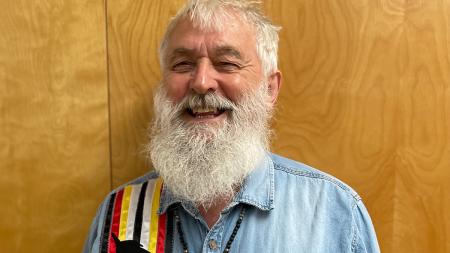Begbie Offers Two Views of Transcendence

Jeremy Begbie began the first of two Stob Lecture Series presentations last week by playing the opening strains of Franz Schubert’s Sonata in G Major.
The music was serene and peaceful as his fingers ran over the keys of the piano in the chapel at Calvin College.
When he finished, he stood and began his lecture, touching on the relationship between music and transcendence as highlighted in the piece he had just played.
“Music can transport us to those hours when our souls soar aloft,” said Begbie, gesturing with his hands.
“This is the music of reverie, leading toward transcendence, to infinite horizons, transporting us across time.”
Begbie is the Thomas A. Langford Research Professor in Systematic Theology at Duke Divinity School and founding Director of Duke Initiatives in Theology and the Arts, one of the main aims of which is to foster theological-artistic links between Duke and Cambridge.
A trained musician, Begbie has published extensively. His particular interest is in the interplay between music and theology, bringing to light the different ways they can illuminate and benefit each other.
Begbie’s first lecture was on Wednesday, Nov. 19, followed by a second Stob lecture on Thursday, Nov. 20. The overall title of the lectures was “What’s Transcendent About the Arts?”
The Stob Lectures are funded by the Henry J. Stob Endowment and are administered by a committee including the presidents of Calvin College and Calvin Theological Seminary
In setting up his first lecture, Begbie asked, “What can music or the arts bring to theology?”
He then went on to say that many people have claimed that the arts offer direct access to "the transcendent," and that this “provides Christians with a golden opportunity to engage with a culture that is wary of the direct proclamation of the gospel.”
But Begbie said God's transcendence is to be understood first and foremost through the gospel itself, not through a person’s one-on-one encounter with a universal presence.
From there, he explained two views of transcendence.
First, Begbie says, there is the point of view that holds that God cannot “be enclosed and wrapped up in human language.”
In this case, Begbie said, we have art emerging from the belief that humans can’t really conceive of God because he is so far beyond them. “God is not of this world,” Begbie said. “God is uncontainable by language and thought.”
People who hold this point of view do not have a personal God. They might look to the power and grandeur of nature or rely on films, books, music, and other forms of art to glimpse a universal power beyond this world.
This approach to transcendence, Begbie said, is reflected in the writing of philosopher Immanuel Kant, the art of artist Kazimir Malevich, known for his famous Black Square painting, and the compositions of those German Romantic and Pre-Romantic composers who saw their music as “a portal to the theological sublime.”
These musicians also believed that instrumental music, devoid of words, was the best way to transport the listener to an encounter with the divine.
“I have a problem with this view of transcendence, especially if we want to connect art to transcendence in our faith life, ” Begbie said.
During his lecture, he showed various images, such as that of Malevich’s The Black Square, on large overhead screens in the chapel. He also stopped to play pieces of music.
In the second half of his lecture, he talked about a different form of transcendence.
Contrary to what the 19th century composers believed, transcendence can come in part by combining words and music in certain ways, especially in worship, as a witness to God, he said.
But this form of transcendence is about more than using various methods, including music and words, in trying to encounter God.
Rather, it is about transcendence in action, which happens by us becoming aware of “the pressure out of which Christianity burst — the unstoppable momentum that erupted in the middle of this world in the form of a real human being.”
Instead of an unreachable God, once who creates awe that makes us gasp or dread that makes us cringe, we have a God “whose transcendence over the world is the transcendence of covenant, commitment, faithfulness,” he said.
In this view, we must consider the Trinity and how God, the Father, Son and Holy Spirit, offers “not bland oneness, but a three-fold life” that we can embrace, Begbie said.
Art, viewed with this perspective, can be a “powerful witness to this transcendence, the transcendence embodied for us in Jesus Christ.
In the end, this type of transcendence is not about some otherworldly presence we can glimpse but never grasp, he said.
Rather, Begbie said, “it is from the one who was born, crucified, and raised from the dead that we learn and relearn transcendence.”


